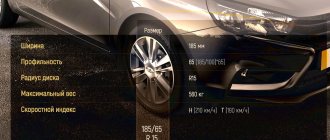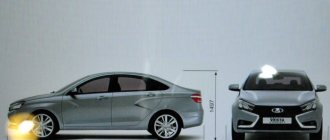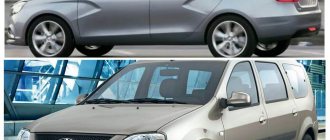AvtoVAZ does not stand still and develops Vesta in new directions. Recently, the world was presented with a sedan in the version of an electric car - Lada Vesta EV. This is a very interesting step from the manufacturer, which can give impetus to the development of environmentally friendly cars in Russia. The Volzhsky Automobile Plant, with the advent of talented foreign experts, has demonstrated clear progress in the automotive industry over the past 10 years. With the release of more and more progressive and modern cars in Togliatti, Russians are beginning to form a new view of domestic cars.
The turning point in the revolution of design and quality, most likely, should be considered the release of the Lada Vesta, which did not leave any motorist indifferent due to its uniqueness and charisma. Today, there are many other innovative projects from various segments in sales and in development, but Vesta rightfully stands out among other models. Let's look at what the second domestic electric car is.
Brief characteristics of the new electric car
The electric car, called Lada Vesta EV, has a built-in motor with a power of 60 kW (80 hp), as well as a lithium-ion battery pack. The electric vehicle batteries are located: the first one is under the hood, the second one is under the rear seat.
The car is equipped with a new safety and comfort system. There is a circuit breaker that allows you to turn off the power to the car during repairs or an accident. The car is driven by an automatic transmission. According to information provided by the creators of the Lada Vesta, the car’s battery is fully charged within approximately nine hours, but if the owner wants to achieve faster charging, he can connect the battery to a network with a power of 380 V, in which case charging will last no more than ninety minutes.
Manufacturers claim that the maximum speed of the electric vehicle reaches only up to 150 km/h, and it will take the driver about 16 seconds to reach it. The car does not have a noisy internal combustion engine, which adds to the car's comfort.
EV – evolution? Test drive of the electric Lada Vesta EV
It was immediately clear that our trip would not be suitable for a full-fledged test drive of an electric car - the journalists taken on board the Vesta EV would only have to do a few laps in a closed area near the AVTOVAZ Museum of Military Equipment. From the Scientific and Technical Center building, where the International Scientific and Technical Conference “Prospects for the Development of Automobiles” is taking place, to the parking lot reserved for “rides”, we are driven by Sergei Nikitovich Ivlev, who has been heading the work on electric vehicles at the Volzhsky Automobile Plant for many years. He is careful - one can feel the long-standing habit of saving charge. In general, this is how an electric car driver should be, but in traffic the electric Vesta does not lag behind its gasoline counterparts. In theory, it should be able to “ignite”... Even if this is only a small test ride, we will try to understand whether any flame will ignite from this electric spark.
Lada Vesta EV – direct contact
The instrument cluster is truly fire. Or lightning, adjusted for its electrical nature. The general configuration and contours of the scales in general repeat the usual “West” ones (in the same way, VAZ previously included ElLada instruments in the Kalinov “tidy”), but they are “drawn” and highlighted in a completely new way - effectively and, most importantly, very informative . In the right roundel there is a completely traditional speedometer. In the center is a large display displaying one of the three positions of the driving mode selector (D, R or N), the power reserve in kilometers and a number of warning lamps. And on the left, instead of a tachometer, there is an ammeter. It is, in fact, an indicator of energy consumption with three zones: blue, in which energy is recovered, green, where energy is spent rationally, and red - a zone of increased consumption.
1 / 3
2 / 3
3 / 3
This beautiful “tidy” and an unusual drive mode selector – that’s all that gives away its electrical essence in the interior of this Vesta. The rest is the interior of a completely production car. There are few differences in the exterior, and this is clearly noticeable from the searching glances of photographers and videographers: what is there to actually shoot here? Remove the stern - the usual exhaust pipe is not visible on it.
You can also open the gas tank flap - the charging socket is hidden behind it.
1 / 4
2 / 4
3 / 4
4 / 4
Well, just for fun, you can open the hood - the entire engine compartment is covered with a huge plastic panel with the new Lada logo. A 60-kilowatt (82 hp) electric motor and part of the batteries are hidden under this panel; the remaining battery units are hidden under the rear seat.
1 / 2
2 / 2
At a special charging station, you will spend about 1.3 hours to charge the batteries of the electric Vesta to 100%, but if there is no special station (and there is none), you will have to charge the car from a household network for nine hours. It’s absolutely true that the El Lada had an hour less (“fast” charging took only half an hour), but in Vesta EV, compared to the electric Kalina, eight batteries were added so that, despite the increased weight of the car itself, the maximum mileage figure was increased by the same figure - 150 km. The batteries themselves are Chinese, VAZ is working with the supplier to increase the capacity, but the main issue remains the price. If only such batteries were made in Russia...
To “start” Vesta EV, you need to turn the key in the lock, in the same way as in a regular car, to the “starter” position. Beautiful scales come to life, on the display, turn on “drive”, take off the handbrake, press on the gas...
Yes, the word “gas” should still be put in quotation marks, and not only because there is no gas as such - the response is so thoughtful that during the first 1-2 centimeters of pedal travel absolutely nothing happens. Against the background of complete silence in the cabin and in the absence of engine sound, this behavior is subjectively perceived as a breakdown - for a second the thought flashes that we will not go anywhere at all.
Perhaps on the test prototype this was done on purpose, as a safety net, but such dissimilarity to what is usually happening under the driver’s right foot is somewhat alarming. I remember that the final copies of El Lada were a little more balanced in this regard - it is clear that the work of Sergei Ivlev’s department on Vesta EV is far from complete.
Sergey Ivlev, head of the department of cars with alternative power plants at AVTOVAZ
But as soon as you set off, you are again overwhelmed with delight - a Russian Lada, but with electricity! Seriously, this sounds almost fantastic! But here it is, the real Vesta EV, confidently accelerating to the barely audible “trolleybus” noise of the electric motor and... the distinct whistle of the vacuum brake booster - however, the vigilant press service of AVTOVAZ informed reporters in advance that the “vacuum” error occurs only on a specific car. There are no complaints about the brakes themselves - despite the added weight, Vesta EV slows down quite intensively from city speeds. But let's wait for a more serious test - it will be interesting to see whether these brakes will have reserve in more difficult conditions.
Perhaps the main thing that needs to be said about the Vesta EV is that the energy recovery in it is really well organized - in about an hour of tests, while drivers who were clearly not inclined to particularly save charge got behind the wheel, the electric Vesta managed to raise the figure for the remaining mileage from 56 to 70 kilometers. Ivlev claims that, skillfully, this electric car can drive not the “passport” 150, but 200 km, and recovery “saves” about 20% of the energy. Ivlev adds a slightly annoying “at most” and stipulates that in winter the actual mileage is reduced to approximately 110 km. A heater organized according to the “electric kettle principle”, when the heating element heats the antifreeze, consumes about 10% of the energy, the same amount is consumed by the climate system air conditioner.
Recuperation is something you will have to get used to. The fact is that you physically feel this process in Vesta EV. As soon as you lift your foot from the gas pedal or even just release it a little, the car goes into braking mode, turning its own electric motor into a generator and diligently accumulating the ampere-hours received from its operation in the batteries. There is no coasting movement here as such - as if in the gearbox, which in reality, of course, also does not exist, one of the lower gears is always engaged. Didn't want to slow down? Next time in this turn, continue to lightly hold the gas.
The whole process of driving an electric car is like this: leisurely, measured, thoughtful. If you switch to Vesta EV from a regular car, you will have to develop completely new reflexes. In the meantime, until they are developed, constantly think about how not to “burn” too much. What if we discard such thoughts? This is easy for our photographer: as soon as Vladimir Miro gets comfortable behind the wheel, he asks Ivlev: “Can I press the gas all the way?” Ivlev nods patiently. The first seconds of acceleration are almost sports car-like; at the moment of start, it seems that the Vesta EV is quite capable of getting out of 8 seconds, or even 7.5... However, after the first powerful impulse, the acceleration extravaganza subsides - it was impossible to accelerate to “hundreds” in a limited space, but in real life this can hardly happen faster than the “passport” 15.5 seconds.
But in the urban speed range, Vesta EV is what you need. There is more than enough dynamics here, and Vesta’s suspension, loaded with extra pounds, becomes a little more comfortable.
A similar thing was observed on El Lada , but on Vesta EV, in addition to this, the original chassis under load retains a much greater margin of controllability and stability. The sensations, of course, are exclusively subjective and so far very superficial, but at this first glance, the electric Vesta is indeed not at all perceived as an overloaded car, prone to rocking and yaw. So, is electro-Vesta about to make a revolution by going on sale ?
To think so would be overly optimistic. Vesta EV is not a revolution. This is evolution, its current crown within the theme of Lada electric vehicles, which, by the way, have been created at AVTOVAZ for 40 years . But right now, tomorrow or in 2017, the Vesta EV is unlikely to reach dealerships - just as all its predecessors have not become truly mass-produced. Probably, it will face a fate similar to the fate of El Lada - the electric Vesta is quite capable of “registering” in the taxi fleets of resort areas. But not more.
From Tesla to Vesta
A couple of hours before our trip, M. I. Podorozhansky, editor-in-chief of Autoreview, spoke at the International Conference in the VAZ Scientific and Technical Center, and it is difficult to disagree with a number of theses of his report. Mikhail Iosifovich noted that successful electric cars are those that... look like electric cars, and not like regular cars. The most successful electric car in the world, the Nissan Leaf, literally screams that it is an electric car. It was this circumstance that allowed it to become much more popular than comparable in characteristics, but ordinary-looking electric cars, obtained by replacing the standard gasoline “filling” with an electric one.
And this replacement is not cheap. The difference in price between a regular car with an internal combustion engine and its electric counterpart, says Podorozhansky, is 100%, no matter what class the cars belong to. In a class that the Tesla Model S recently burst into, paying twice as much for the electrification of your vehicle looks like an investment in your own status, a declaration of “environmental friendliness” and emphasizing your proximity to high technology. And in the class of “state employees,” which includes the Lada Vesta, people value completely different things. “What will I get from this?” - that's their main question. The answer is nothing. At their current price, electric cars do not pay for themselves, no matter how cheap electricity is and no matter how much gasoline prices rise. But with the development of technology, electric cars will inevitably become cheaper and more accessible than the currently popular rechargeable hybrids (PHEV), since the latter, in addition to the electric motor, also contain a traditional internal combustion engine.
Mikhail Podorozhansky, editor-in-chief of Autoreview
Another speaker at the conference, K. Yu. Kotlyarov, project manager in the Service of the Executive Vice President for Engineering (SVPI) at AVTOVAZ, noted that by 2025, 30% of all vehicles will have alternative power plants. The Volzhsky Automobile Plant has plans to quickly launch into series the carrier of “today’s technology,” Vesta CNG (we will return to the topic of bi-fuel Vesta in the near future), and also has completed R&D level developments within the framework of the state contract for hybrid cars. Konstantin Yuryevich also remembered that there was an interesting project at AVTOVAZ for a fuel cell car ANTEL , but noted that further work bringing this car closer to reality and providing for the production of hydrogen from methane cannot be carried out by the Volzhsky Automobile Plant alone - a serious federal program and cooperation is needed automakers.
Konstantin Kotlyarov, project manager at SIVPI AVTOVAZ.
But electric cars “in the long term” seem to Kotlyarov to be the most interesting cars. Agreeing with Podorozhansky, he says that the capacity of batteries is gradually increasing, and the price of components is falling, and although “not so much as to be very optimistic - we can’t expect miracles,” progressive technical solutions will gradually move from expensive classes to more budget ones, and the main thing for AVTOVAZ is to be ready for this. One of the priority areas is the localization of battery production in Russia, their use in the domestic market and export delivery. Electric vehicles have their own niche, but to start production, volumes are needed, standardization and unification of power plant components among Russian suppliers is needed, as well as state support through special programs. All this will help reduce prices for Lada electric vehicles to a competitive level. For now, Vesta EV is not a production car, but a prototype undergoing testing.
Harold Grübel, Vice President of Engineering at AVTOVAZ and Pavel Sereda, Director of the Light Commercial and Passenger Vehicles Division of the GAZ Group.
The third interesting report on the topic of electric vehicles was made by P.V. Sereda, Director of the Light Commercial and Passenger Vehicles Division of the GAZ Group. He is convinced that the time for CNG technology has already been lost, but the topic of electric vehicles will begin to develop rapidly in the near future, and primarily in the niche of commercial vehicles. In addition, autonomous vehicles for commercial transportation have great prospects. GAZ is already building electric drones: the first prototype will be the Gazelle NEXT , and in 2017-2018 these technologies will be used on all vehicles in the GAZ model line without exception. For now – also within the framework of prototypes and sea trials. But in the future, GAZ may open up unprecedented opportunities for optimization and saving money and resources for shipping companies. He is actively developing the topic of electric drones and KAMAZ - this follows from another report made by the chief designer for innovative products of KAMAZ PJSC S. V. Nazarenko.
As for one of the most pressing problems of electric vehicles - infrastructure, then if we consider electric transport not a complete alternative to the existing gasoline one, but simply one of the types of transport of the near future that occupies its own niche, then this problem may turn out to be largely far-fetched. Commercial electric vehicles, as P.V. Sereda noted, will always have a clear rhythm of movement, so organizing its charging will not be very difficult. Just like now, this problem does not exist for the majority of owners of electric vehicles, because, according to Podorozhansky, these are mostly wealthy people, executives who charge their car during the day in the office parking lot and at night in the garage of their home. As for potential owners of low-cost electric cars of the future, the number of charging stations for public use will inevitably increase. This is a slow process, but it is already underway.
Articles / Practice Do-it-yourself electric car: how, why and how much it costs Today, electric transport is presented by marketers as a carrier of the most advanced technologies in the automotive industry. And many are sure that an electric car can be either expensive, like a Nissan Lea... 147852 7 22 09/01/2016
For example, PJSC Rosseti actually became the very first buyer and user of electric vehicles in Russia from the moment they appeared on the Russian market, having assessed their medium and long-term prospects. But Rosseti not only launched a long-term program for testing electric vehicles - they also opened the first network of filling stations for electric vehicles - MOESK-EV. Now it includes 60 charging stations: 30 in Moscow and the region and the same number in the regions - St. Petersburg, Sochi, Yaroslavl, Yekaterinburg, Ryazan, Orel and on Valaam Island - and at all stations all users can charge for free! As for the potential expansion of the network, according to representatives of Rosseti, it took them from several days (!) to several months to install the above-mentioned electric charging stations - that is, theoretically, the time frame for building a “real charging network for everyone” appears quite foreseeable.
Several conference speakers at once expressed the idea that the Russian automotive industry needs promising modular platforms that could be used by various automakers... Is this possible? Massive and therefore inexpensive modular platform, cheap and powerful Russian-made batteries, a design different from a “regular car”, an interior familiar to the younger generation “Z” with a touchscreen instead of conventional keys and selectors, a clear charging system... The prospects are beautiful, but how many times has this happened already? “imagined future” was postponed until the next decade?
There will be no revolution. There will be an evolution, and a very slow and local one, in certain segments of motor transport. Still, let's allow ourselves cautious optimism and consider Vesta EV an excellent prototype. And one of the signs of the coming electrical era.
Survey
What do you think about the Vesta EV project?
Your voice
Total votes:
Lada Vesta for three million rubles
When talking about the cost of any electric car, motorists traditionally imagine huge sums, reaching many millions of rubles. However, with the progressive use of this transport in the global industry, many are convinced that it is possible to purchase such a car without spending huge sums on its purchase.
The electric car Lada Vesta is estimated by experts at approximately 45 thousand dollars, which in ruble equivalent means an amount of 3 million rubles. We agree that the cost offered by manufacturers is not particularly significant for an electric vehicle. On average, the cost of electric cars in Russia is from 5 million rubles.
“Made with us” and on Yandex.Zen
What to build on if you are losing money every year? Right! Loans, subsidies, government support. Kickbacks and peeling? You're crazy, this is only possible in wild Russia. Only civilized lobbying.
Los Angeles entrepreneur Elon Musk has created multibillion-dollar companies that make electric cars, sell solar panels and launch rockets into space.
And he created these companies with the help of billions in government subsidies.
Tesla Motors Inc., SolarCity Corp. and Space Exploration Technologies Corp., known as SpaceX, have together used $4.9 billion in government support, according to The Times. The figure shows how his empire was formed: a public-private model for financing start-ups.
The model includes various government incentives, including grants, tax breaks, plant construction, preferential lending and environmental incentives. It also includes tax breaks and rebates for buyers of solar panels and electric vehicles.
Tesla and SolarCity continue to report net losses after ten years in business, but both companies' equity has soared; Musk's share alone is about $10 billion.
What Musk and investors like best is the government's financial support, while taxpayers look at the amounts they pay.
There will be a benefit to society if solar panels and electric vehicles become competitive in the mass market. They are currently niche products for wealthy clients.
The subsidies were discovered through a review of company records and reports. But the full amount of government assistance has not been calculated because it was provided over time and at different levels of government.
New York State is spending $750 million to build a solar panel factory in Buffalo for SolarCity. San Mateo, California, will lease the plant for $1 per year. He won't pay property taxes for ten years, which is equivalent to $260 million.
The federal government also provides grants or tax credits to cover 30% of the cost of installing the panels. SolarCity reported receiving $497.5 million in direct subsidies from the Treasury.
This figure, however, does not reflect the full cost of government support.
Since 2006, SolarCity has installed 217,595 systems for customers. If everyone paid about $23,000, that would amount to about $1.5 billion in grants for the government for SolarCity.
Nevada has agreed to give Tesla $1.3 billion in incentives to build a huge battery plant near Reno.
The Palo Alto company raised more than $517 million from rival automakers by selling environmental credits. Under the regulatory system adopted by nine states, automakers must buy credits if they fail to sell enough zero-emission vehicles.
SpaceX snagged a deal for $20 million in Texas economic development grants to build a launch facility. (Separately, SpaceX won $5.5 billion in contracts from NASA and the US Air Force).
Government money for Tesla and SolarCity factories is critical for both companies. Tesla buyers receive a $7,500 federal tax credit and a $2,500 rebate from the state of California. California recently passed a law, which has not yet gone into effect, restricting purchases of electric vehicles. Tesla owners have an average household income of about $320,000.
etc.
Advantages and benefits of the new Lada Vesta
Among the main advantages of Vesta are: the absence of malignant exhausts that pose a threat to the environment and human health; durability and quality of engine use; charging electric car batteries from a regular electrical outlet, which will significantly reduce the costs of motorists;
high efficiency of the engine in comparison with other cars, less noise generation, emergency braking, which is a direct advantage for the safety of motorists.
Lada Vesta in the future
At the moment, only one copy of the Lada Vesta electric car has been created in Russia, however, for the purpose of further checks and tests of the car, it is planned to release several more such copies. The release of new models, as well as their practical use, involves studying the characteristics of an electric vehicle, its advantages and disadvantages in order to make changes to its modification to optimize operation.
Initially, the mass production of the Lada Vesta series was not intended by the manufacturers, however, some representatives of AvtoVAZ are already claiming that the organization will think about producing cars for personal consumption by citizens if there is a demand for electric cars. Meanwhile, as stated by auto professionals, the Russian car market is aimed at developing infrastructure for electric cars. In September 2015, information appeared that it was planned to install a thousand charging stations in the country by the beginning of 2022.
Methane instead of gasoline?
At the end of 2015, AvtoVAZ introduced followers of the domestic auto industry to another version of Vesta with an alternative power plant. The public was presented with an experimental dual-fuel car Lada Vesta CNG , which can be filled with gasoline and methane. To do this, it was equipped with two gas cylinders, they were placed under the trunk floor.
A fully fueled dual-fuel vehicle can travel 1,000 km without refueling, approximately 300 km of which on gas. AvtoVAZ representatives claim that using methane instead of gasoline will reduce fuel costs by 3 times.
Let us remind you that in less than a month at the Moscow Motor Show, AvtoVAZ will present two Lada Vesta station wagons (regular and all-terrain cross), as well as, possibly, an off-road version of the Lada X Ray Cross.
Electric cars in Russia: a brief history
By the way, the production of experimental car models is not a new direction in the activities of AvtoVAZ. Over the past few years, the automobile plant in Tolyatti has produced several such experimental cars. Among such cars are the Lada Granta, which has a hybrid power plant, and the Hellas electric car. However, in the future, these models were not produced for sale. Thus, Lada Vesta EV is not a pioneer among electric vehicles in the domestic market.
The new Lada Vesta FL 2022 refuses to drive: it has already been released with a serious flaw
As you know, the new Lada Vesta FL should debut on the Russian automobile market this year. Recently, information appeared on the Internet that to date, 200 new cars have already been assembled at AvtoVAZ’s production facilities. At the moment, these models are used for testing and identifying possible shortcomings. It is expected that the batch of test cars will allow AvtoVAZ to maximally prepare its updated flagship for its debut on the domestic market.
Recently, information appeared that during the testing process the manufacturer was able to identify a significant defect in the updated model, which could slow down the production of the car. It is noteworthy that the flaw was identified in an option that should debut for the first time on an updated Russian car. It is worth noting that a corresponding video has already been released on our Youtube channel Naavtotrasse.ru regarding the new product. According to sources close to AvtoVAZ, about half of the cars tested were rejected.
In this case, we are talking about an electronic instrument panel, which will become an innovation for a Russian car (photo: Avtograd news). Let us remind you that previously the LADA Vesta was equipped with a classic “tidy” with analogue dials. It is noteworthy that a malfunction in the digital instrument panel entails the failure of all on-board electronics of the car. As a result, the car simply refuses to go further until the problem is fixed. It is worth recalling that the Russian company planned to launch an updated domestic model in the spring of this year.
Also, in the early spring of 2022, the manufacturer intends to launch production of ready-made production units for subsequent delivery of cars to Lada dealerships. In dealerships, the first production models will have to be displayed as display samples. With their help, Russian car enthusiasts will be able to get acquainted with Vesta FL, as well as conduct test drives and learn in detail about the technical characteristics of the updated car. As for the start of free sales, this event should take place a little later.
According to preliminary data, AvtoVAZ will launch free sales of the Lada Vesta FL in May of this year. Given the discovery of a serious defect, it is possible that the release of the car will be postponed to a later date until the manufacturer fixes the problem and conducts additional tests. In terms of its characteristics, the updated Vesta FL will not differ so significantly from its predecessor. The manufacturer focused on modernizing the exterior and interior design. The technical part of the car will not undergo any significant changes. Author: Oleg Mokrov











